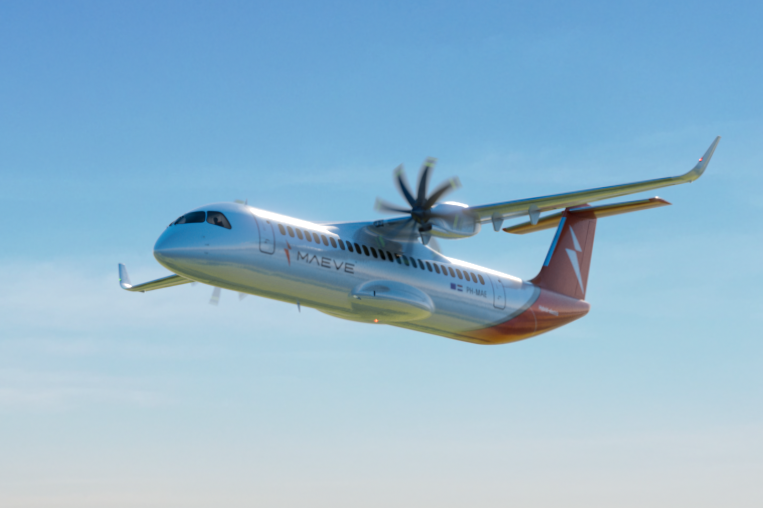
Faster than current turboprops, the M80 has been designed to cruise at a speed of 400 kt. flying at 35,000 ft.
FRANKFURT—Maeve Aerospace has started research and development work on an 80-seat hybrid-electric turboprop that is targeted at the regional jet and De Havilland Canada Dash 8-400 replacement market.
Maeve's aircraft, named the M80, is to make its first flight at the end of 2028 and enter service in 2030/31.
The M80 is an all-new airframe with swept, high wings and newly developed turboprop engines supplemented by battery power during takeoff and climb. The European startup is close to revealing a memorandum of understanding with an undisclosed engine manufacturer, a step expected for the beginning of 2024.
The hybrid configuration of the engine combined with higher aerodynamic efficiency will lead to around 40% lower fuel burn in cruise than the aircraft it is replacing, Maeve claims. Trip costs are to be 25% lower than those of similarly sized regional jets and seat-mile costs 20% below current turboprops. The M80 is to be certified for use of 100% sustainable aviation fuels (SAF) from the outset.
Set up in Delft, Netherlands, the startup launched in 2021 with plans to develop the Maeve 01, a fully electric, four-engined 40-seat aircraft that was to fly up to a range of 200 nm. That concept has now been dropped in favor of the two-engined hybrid M80.
“A fully electric aircraft would only have worked with a performance level that would not have met market requirements,” Chief Technology Officer Martin Nuesseler tells Aviation Week.
Maeve is only the latest to move away from a fully electric concept. Sweden-based Heart Aerospace is now following a hybrid design for the 30-seat ES-30 after starting out pursuing development of a fully-electric aircraft.
Nuesseler previously held senior roles on the Airbus A350 and A400M programs but joined Maeve after holding a role at Deutsche Aircraft in Oberpfaffenhofen near Munich. Maeve is now building its own engineering operation in Oberpfaffenhofen, where it has access to engineering talent. Other aerospace firms, including Lilium, are also based at the site. The airport has also been the historic base of Dornier Luftfahrt and later Fairchild Dornier.
Deutsche Aircraft has been working on a modernized and stretched version of the Dornier 328, the 40-seat 328Eco. But Nuesseler was unconvinced and moved on to join Maeve.
“The market under 50 seats is going to disappear,” Nuesseler predicts. “Because of cost pressures, a new aircraft has to have at least 80 seats. We need a new benchmark in payload efficiency. The most important thing is to use less energy.”
The M80 concept is that of an efficient high-speed turboprop that can fly at altitudes of up to 35,000 ft. and that specifically avoids competition with the ATR 72. “Our aircraft is more efficient than the ATR, but the ATR has an unbeatable cost structure in its niche,” Nuesseler says, referring to the typically very short sectors the aircraft is operating on.
The Maeve aircraft is to cruise at a speed of 400 kt. at 35,000 ft. An operational range of 800 nm is targeted. The ATR 72 has a range of 740 nm.
According to Nuesseler, Maeve can reduce the size of the engine because additional battery power is being used for takeoff and climb. The engine will not lose efficiency at altitude because of an additional thermal process to densify the air ahead of the compressor.
The cabin is arranged in a four-abreast configuration and can seat up to 84 passengers in a single class or 76 in dual-class layout.
The M80's 10 battery packs are placed in the cargo hold and are attached to the passenger floor. The fuselage is designed in an oval shape to allow for sufficient cargo space below the passenger deck and for enough clearance for the batteries, which will be separated from the aircraft’s main structure for safety reasons.
Operationally, Maeve is following two different options: Batteries could be recharged on the ground by charging trucks battery-to-battery or could be recharged during descent.
“I believe we will be charging on the ground,” Nuesseler says, but that decision will hinge on feedback by airlines. Batteries will have to be replaced after around 1,800 cycles or on an annual basis.
Maeve’s roadmap includes finalizing the preliminary agreement with its engine supplier, a core element of the aircraft’s concept. “The engine partner has a strong interest in promoting our product because it demonstrates the engine’s capabilities,” Nuesseler says. A testbed using a prototype of the engine is to fly next year.
Then, Maeve is in the process of finding an industrial lead investor. Maeve has so far received funding from private investors, the Dutch government and the European Innovation Council.
Maeve aims at reaching the preliminary design review (PDR) for the M80 by 2026. Nuesseler says he has built in more time than usual to ensure the product is highly mature at that stage.
Industrialization is to follow from 2026. Maeve is still some way off selecting a site, but Nuesseler says Oberpfaffenhofen is a possibility.

Comments